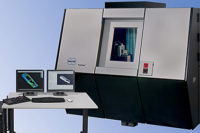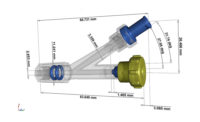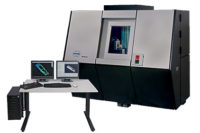Industrial radiography is a nondestructive testing method used to aid in looking below the surface of any given material for irregularities. When radiography was discovered and first implemented, it was mainly utilized for medical type purposes. As time passed, its results were discovered to be a valuable inspection tool for numerous manufactured items in the industrial field. Welds and metallic castings are inspected frequently these days using industrial radiography which helps to reveal defects in the material hidden below the surface. This inspection delivers extreme benefit to manufacturers as it provides quality assurance of the product and does so without sacrificing material or destroying samples. In this day and age, taking advantage of further test method development along with the increased use of polymeric materials, X-ray inspection has grown as a reliable examination method for numerous types of plastic, silicone, microchips and rubber.
This method of testing can be accomplished while conforming to various industry specifications for the inspection. References may be made to ASTM (American Society for Testing and Materials), ASME (American Society of Mechanical Engineers), or MIL (United States Military Standard) specifications, procedures and specific criteria for the evaluation. Technicians performing the inspection and evaluating samples are normally certified as per an organization like ASNT (American Society for Nondestructive Testing). If an independent test laboratory is contracted to perform the evaluation they have the ability to issue a certified test report after the inspection to outline any results found during the test. When purchasing material it may be important to request documentation that the product was tested and did conform to the relevant specification. With all methods of science, a good experiment is repeatable. Each of these specifications outline limits and create standards to ensure the repeatability of the inspections being performed.
Radiographic inspection has many advantages. It is a nondestructive examination, meaning that the given sample can be tested and results can be determined all without sacrificing the part. Under normal circumstances, the test can be performed by utilizing either of these two methods:
• Computed Radiography with Digital Results (CR)
• Conventional Radiography using Film (XR)
After an exposure using the conventional radiography (XR) method, a silver bromide based industrial film is developed by means of either manual or automatic processing. The image is then examined to ensure the shot quality is sufficient. These films are then evaluated against a specific criteria. This exposed film used in the evaluation serves as a permanent record for the part from that point forward. With proper storage techniques, these images can be called upon years later for re-evaluation or quality control. In some circumstances, the part that was inspected can be re-radiographed after time in service and the new images can be compared to the original films for signs of deterioration in the sample. For conventional radiography images, extremely fine grain industrial film can be utilized. This film is able to produce a particularly detailed high contrast image.
Computed radiography (CR) is able to utilize conventional X-Ray equipment to expose the image but a digital file is created. This is done by utilizing a phosphor based imaging plate in lieu of physical film. Once the imaging plate is exposed it is loaded into a scanner and digitized results are then displayed on a high-resolution screen or computer monitor. These images will not degrade over time and may be stored compactly on a disc or hard drive, ensuring that quality records are filed and can be recalled with great ease. As an added benefit, while being viewed, these images may be adjusted to increase contrast, control exposure and zoom areas of greater interest. This can be done while preserving the unaltered “as radiographed” original image.
With both of these methods the results can be achieved using relatively low energy (KV, Ma) and minimal time, making them highly efficient and accurate methods for inspecting a number of unique samples. Below I give some examples of how radiographic inspection, both XR and CR, may provide value in the manufacturing or proofing of plastic and electronic components.
Individuals or companies involved in the manufacturing of transformers, transceivers, delay lines or semiconductors find radiographic inspection a useful tool in showing their customer that any given sample is completely free of foreign debris inside of its casing. This assurance provides confidence as it helps to eliminate risks of any possibility of shorts and provides a comprehensive layout of the part’s internals. Results can be independently generated to validate traceability and prevent human intervention. In this industry, computed radiography is especially useful as its process provides the manufacturer and their client with images that can be efficiently transferred and shared, if required.
Often times in the medical field, radiography is a necessary tool to ensure that instrumentation meets the clinical needs of the market. This may involve a stipulation dictating that the sample be inspected to measure its opaqueness as it relates to final use in a fluoroscopy study. Parts with a need to be tested include but are not limited to all types of catheters, implantable ports, sheaths, dilators, guide wires, needles and tubing. An X-Ray Phantom can be created from a low density material such as aluminum and can be placed between the sample and X-Ray source to simulate tissue and provide a more accurate comparison to the instrument’s final end use. The use of physical film may be required in these cases as it better simulates the images used during the eventual application of the device.
With all of the new advances of plastics noted in recent years, the demand for custom injection moldings is more prevalent. Injection molding of samples is a widely used method of producing high volumes of identical components. Tight tolerance applications leave no room for defects or abnormalities in the samples. Radiographic inspection is useful for these molds as it provides a cost effective, non-invasive way to identify voids and assure one hundred percent compliance of the component. In turn, the inspection prevents the need for any destructive testing or scrapping after or during further value added services, such as cutting, machining or assembling. In a similar situation, manufacturers can purge and quarantine material samples before and after mold runs. These specimens can be examined and fully checked for foreign material within specific lots. Both computed radiography and conventional film-based radiography may be utilized here depending on requirements.
Lithium power source batteries are often used for aerospace and defense applications. These batteries have the utmost need to perform with extremely high reliability as they are used in some of the most demanding applications (space, weapon systems, electronic fuzing, etc.). Radiographic analysis may be required to inspect for proper assembly, Foreign Objects (FOD), and other build issues associated with the robotics or personnel that are assembling them. Again, radiographic inspection is a beneficial technique as it is a cost-effective nondestructive method of inspection. Depending on the end user, many aerospace and defense projects do require the recording of information on X-Ray film. When film is not required, the computed radiography method can be used to assist with battery development and evaluations. A screen capture option may provide benefit and assist with adding radiographic images to reports, and /or to operator instructions.
Museum curators or archivists often times find radiographic inspection a unique tool. Paintings may be inspected to find documents hidden inside the frames or to study underpainting layers. Plaster molds or statues may be examined to observe their internal structure for signs of deterioration. Again, depending on circumstance either computed radiography or conventional film-based radiography could be used in these instances.
Another unique use for radiographic inspection (CR or XR) is in fire investigation and in turn, litigation. During an investigation, a damaged component (e.g. power-strip, ceiling fan, etc.) can be quarantined as an exhibit. Films from the X-Ray of this sample can be examined to determine if it has specific relevance in the analysis of a fire. These images can be used in a court setting and may prove to be significant in determining the party responsible for a loss.
In summary, radiographic inspections of all non-metallic materials is a growing industry. Results are quick and exceptionally accurate. This keeps production moving and assures utmost confidence in the goods being manufactured or preserved.







